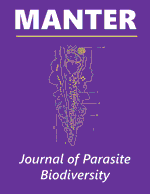Parasitology, Harold W. Manter Laboratory of

MANTER: Journal of Parasite Biodiversity
Date of this Version
7-21-2017
Document Type
Article
Citation
MANTER: Journal of Parasite Biodiversity
Occasional Papers, Number 7, July 21, 2017
doi: 10.13014/K2ZG6QDX
Abstract
Based on original data obtained from fieldwork conducted from January 2008 to December 2015 and from previous records from published accounts, an updated checklist of helminth parasites of bats from Mexico and Central America is presented. The checklist has been organized in four ways, first as a helminth-host list in the state of Morelos, second as a helminth-host list with taxonomic and geographic distributional information, third as a bat-helminth list with references, and last, as a summary of the host-helminth association. A total of 105 records and 67 helminth taxa (26 trematodes, 4 cestodes, and 37 nematodes [33 adult and 5 larvae]) in 27 bat species from the families Emballonuridae, Molossidae, Mormoopidae, Natalidae, Phyllostomidae, and Vespertilionidae are presented for Mexico and Central America. Eight species of helminths are unique to Central America and ten species occur in both Mexico and the isthmus. From the helminths recorded in Mexico, 34 helminth species in 19 species of bats are present in the state of Morelos. The helminth diversity represents 58% of the total recorded thus far in Mexico, yet the diversity of bats intensively surveyed for parasites in the country represents roughly 14% of the diversity of chiropterans present. This evidence suggests that these intensive examinations are necessary to complete the helminthological record for bats, especially in areas of high endemism.


Comments
Copyright © 2017, Jiménez, Caspeta-Mandujano, S. B. Ramírez-Chávez, S. E. Ramírez-Díaz, Juárez-Urbina, Peralta-Ramírez, and Guerrero
License: CC BY-NC-SA 4.0 International
The archive of record for nomenclatural acts in this journal is the Internet Archive